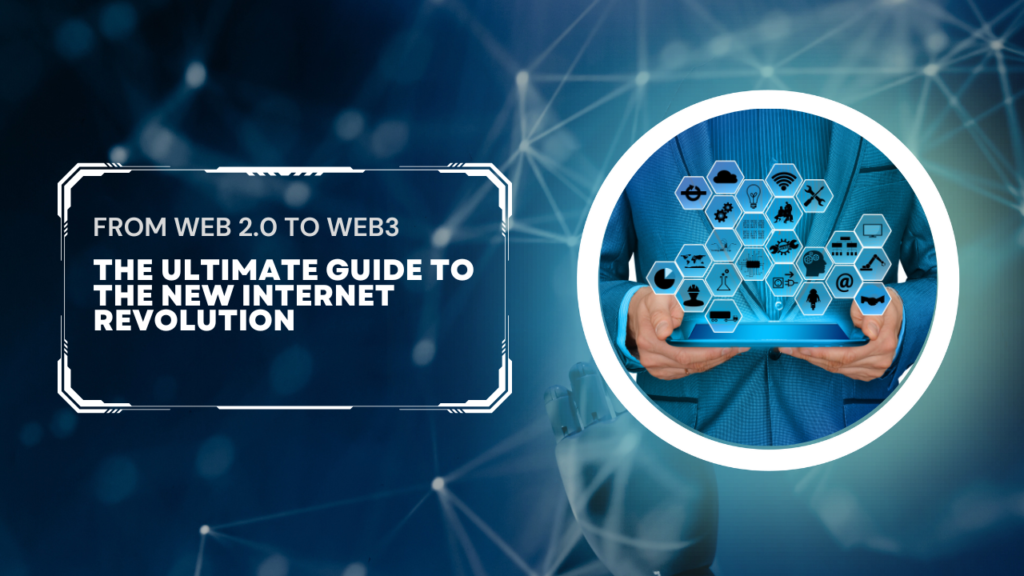Introduction to Web3
Web3, the next phase of internet evolution, is a paradigm-shifting concept that aims to revolutionize how we interact and transact online. In this article, we delve into the fundamental principles, technologies, and potential of Web3. We explore the transition from Web2 to Web3, highlighting the core concepts such as decentralization, blockchain technology, and smart contracts. Additionally, we examine the impact of a decentralized web on various sectors, discuss the foundational technologies and infrastructure behind Web3, explore real-world use cases, and address the challenges and limitations that must be overcome. Finally, we envision the future of Web3 and its transformative potential for society and industries. So, join us on this journey as we deepen our understanding of Web3 and its implications for the digital landscape.
What is Web3?
Web3, short for Web 3.0, is the next internet generation that aims to decentralize the online experience. It envisions a digital landscape where power is distributed among users, removing the reliance on central authorities and intermediaries. In Web3, individuals have more control over their data, online interactions, and digital assets.
Evolution from Web2 to Web3
Web3 is a significant evolution from Web2, which refers to the current iteration of the Internet we use today. Web2 is characterized by centralized platforms and services like social media networks and online marketplaces. While Web2 has brought convenience, it has also led to concerns over data privacy, censorship, and the concentration of power in the hands of a few tech giants.
Web3 introduces decentralized technologies like blockchain to create a more inclusive and transparent online ecosystem. It aims to empower users, foster peer-to-peer interactions, and enable decentralized applications (dApps) development with built-in trust and security.
Why Web3 Matters?
Web3 matters because it addresses some of the fundamental issues of Web2. By decentralizing power and data control, it offers individuals greater privacy, security, and autonomy. Web3 also opens new possibilities for innovation, economic opportunities, and collaboration.
Moreover, Web3 could disrupt various industries, including finance, supply chain management, healthcare, etc. It enables the creation of decentralized finance (DeFi) platforms, self-executing smart contracts, and decentralized applications that can revolutionize traditional processes.
Understanding Web3 is essential in navigating the Internet’s future and embracing its potential benefits.
Key Concepts and Principles of Web3
Decentralization
Decentralization lies at the core of Web3. It refers to distributing power, control, and decision-making authority among a network of participants rather than relying on a central authority. In Web3, decentralization fosters trust, transparency, and resilience while minimizing the risk of single points of failure.
Blockchain Technology
Blockchain technology is a crucial enabler of Web3. A distributed ledger records transactions and ensures data integrity through cryptographic techniques. Blockchain eliminates the need for intermediaries, providing a transparent and tamper-resistant system for verifying and storing information.
Smart Contracts
Smart contracts are self-executing contracts with the terms of the agreement directly written into code. They automatically enforce the rules and conditions outlined within the contract, removing the need for intermediaries. Smart contracts enable trustless interactions, automate processes, and enable secure and transparent transactions.
Interoperability
Interoperability refers to the ability of different blockchain networks and decentralized applications to communicate and interact seamlessly. It ensures that Web3 technologies can work together, allowing data and assets to move across multiple platforms, enhancing efficiency, and unlocking new possibilities for collaboration.
Decentralized Web and Its Impact
Understanding Decentralization on the Web
In the decentralized web, data is stored and distributed across a network of computers rather than being stored on centralized servers. This distributed approach ensures redundancy, resiliency, and censorship resistance. It also lets individuals control their data, enabling them to share or revoke access as they see fit.
Advantages of Decentralized Web
The decentralized web offers several advantages. It enhances data privacy by reducing the reliance on centralized platforms that collect and monetize user data. It also reduces the risk of data breaches and unauthorized access since data is spread across multiple nodes.
Additionally, the decentralized web enables peer-to-peer transactions without intermediaries, reducing transaction costs and increasing efficiency. It also empowers individuals in regions with restricted internet access or censorship, allowing them to access information and participate more freely.
Disadvantages and Concerns
Despite its advantages, the decentralized web still faces challenges. It may be slower and less scalable than centralized counterparts due to the need for consensus mechanisms. There are also concerns about energy consumption, as blockchain networks require significant computational power.
Moreover, the decentralized web raises questions regarding governance, standards, and regulations. It requires collaborative efforts to establish frameworks that ensure fairness, security, and accountability.
Web3 Technologies and Infrastructure
Blockchain Platforms in Web3
Web3 relies on various blockchain platforms, such as Ethereum, Polkadot, and Cardano, to enable decentralized applications and smart contracts. These platforms provide the infrastructure for building and deploying Web3 solutions, each with unique features and capabilities.
Decentralized Storage and Computing
Decentralized storage and computing solutions, like I.P.F.S. (InterPlanetary File System) and Swarm, are vital in Web3. They distribute and store data across a network of nodes, ensuring redundancy and accessibility while mitigating the risk of central points of failure. Decentralized computing platforms like Golem and iExec leverage idle computing power to provide decentralized computational resources.
Identity Management in Web3
Identity management in Web3 focuses on empowering users to control their digital identities. It aims to enable self-sovereign identity, where individuals have ownership and authority over their personal data. Technologies like decentralized identifiers (D.I.D.s) and verifiable credentials help establish trust and privacy in online identity management.
Web3 Development Frameworks
Web3 development frameworks, such as Truffle and Embark, provide tools and libraries to facilitate the creation of decentralized applications. These frameworks simplify the process of coding, testing, and deploying smart contracts and dApps, enabling developers to build on Web3 technologies more efficiently.
By understanding the technologies and infrastructure of Web3, developers, and entrepreneurs can leverage these tools to build innovative solutions that reshape the digital landscape.
Web3 Use Cases and Applications
DeFi (Decentralized Finance)
DeFi, short for Decentralized Finance, is one of the hottest buzzwords in the Web3 world. It refers to using blockchain technology to recreate traditional financial systems in a decentralized and trustless manner. With DeFi, you can lend and borrow money, trade digital assets, and earn interest without relying on intermediaries like banks. It’s like traditional finance on steroids, where anyone with an internet connection can participate and benefit.
NFTs (Non-Fungible Tokens)
NFTs, or Non-Fungible Tokens, have taken the art world by storm, and they’re a prime example of Web3 innovation. Unlike cryptocurrencies such as Bitcoin, NFTs represent unique digital assets that can be bought, sold, and owned. From digital art pieces to virtual real estate, NFTs provide a way to securely authenticate and trade digital assets. It’s like collecting rare baseball cards but in the digital realm.
Supply Chain Management
Web3 technology also holds vast potential for transforming supply chain management. By utilizing blockchain’s immutable and transparent nature, businesses can track the movement of goods from the source to the consumer, ensuring authenticity and preventing counterfeiting. This strengthens trust in the supply chain, improves efficiency, and reduces costs. Imagine knowing exactly where your favorite coffee beans came from or verifying the authenticity of luxury goods with a tap of your smartphone.
Decentralized Social Media
Social media has become integral to our lives, but it’s no secret that centralized platforms have flaws. Web3 offers an alternative by enabling decentralized social media platforms. These platforms are built on blockchain technology, distributing control and ownership among users. Say goodbye to data breaches and censorship and hello to a more democratic and user-centric social media experience. Your following tweet might even earn you some cryptocurrency!
Challenges and Limitations of Web3
Scalability and Performance
While Web3 has tremendous potential, it still faces challenges in terms of scalability and performance. As more users join the network, blockchain systems can become slower and more congested. Scaling solutions such as layer 2 protocols and sharding are being developed to tackle these issues, but widespread implementation is still a work in progress. Web3 needs to level up its game to handle the demands of a global user base.
User Experience and Adoption
For Web3 to truly revolutionize the world, it must be accessible and appealing to the masses. Currently, the user experience of interacting with decentralized applications (dApps) can be confusing and clunky, deterring mainstream adoption. Improving user interfaces, simplifying processes, and enhancing education are crucial steps to bridge the gap between Web2 and Web3. After all, only some people want to feel like they need a Ph.D. in computer science to use a decentralized app.
Governance and Regulation
Questions regarding governance and regulation arise as Web3 disrupts traditional systems and challenges existing power structures. Who makes the rules in a decentralized world? How do we ensure fair play? These complex issues require thoughtful consideration and collaboration between technologists, policymakers, and communities. Striking the right balance between innovation and accountability is essential to navigate the uncharted waters of Web3.
Future of Web3 and its Potential
Emerging Trends in Web3
Web3 is an ever-evolving landscape, and several exciting trends are on the horizon. From decentralized autonomous organizations (D.A.O.s) that enable community-driven decision-making to cross-chain interoperability that connects different blockchain networks, these trends push the boundaries of what’s possible in the Web3 space. The future looks bright and filled with endless possibilities.
Web3 Integration with Web2
The transition to Web3 means we can continue the wonders of Web2. In fact, integrating the best of both worlds is a possibility. We can harness the decentralized nature of Web3 and combine it with the convenience and familiarity of Web2 applications. This hybrid approach could make Web3 more accessible and accelerate adoption, allowing us to enjoy the benefits of both paradigms.
Potential Impacts on Society and Industries
Web3 has the potential to revolutionize various industries and reshape societal structures. From financial systems empowering the unbanked to transparent supply chains prioritizing sustainability, Web3 opens up new possibilities for fairer and more inclusive approaches. It challenges the status quo and offers alternatives prioritizing decentralization, privacy, and user empowerment. The impact could be transformative, and it’s up to us to shape it responsibly.
Conclusion: Embracing the Web3 Era
Web3 is not just a buzzword; it’s a paradigm shift that can potentially transform our digital lives. We can create a more equitable, transparent, and innovative future by embracing decentralization, trustlessness, and user empowerment. While challenges remain, the possibilities that Web3 offers are too enticing to ignore. So let’s roll up our sleeves, explore, experiment, and together, shape the future of the Internet. The Web3 era awaits us, an exciting journey we want to take advantage of!
In conclusion, the emergence of Web3 signifies a significant shift toward a more decentralized, secure, and transparent Internet ecosystem. With its key concepts, technologies, and use cases, Web3 has the potential to reshape industries, enhance user privacy and control, and foster innovation on a global scale. While there are challenges to address, such as scalability and adoption, the future of Web3 looks promising. By embracing the Web3 era and actively participating in its development, we can unlock new possibilities and build a more inclusive and democratized digital world. So, let’s seize the opportunities presented by Web3 and embark on this transformative journey together.
F.A.Q.
What is the main difference between Web2 and Web3?
Web2, or the traditional web, is primarily centralized, relying on several entities to store and control user data. In contrast, Web3 is characterized by decentralization, utilizing blockchain technology and smart contracts to enable peer-to-peer interactions, data ownership, and enhanced security.
How does Web3 impact industries like finance and social media?
Web3 has significant implications for various industries. It enables decentralized finance (DeFi) applications, such as lending, borrowing, and yield farming, without traditional intermediaries. In social media, Web3 creates decentralized platforms prioritizing user privacy, content ownership, and community governance, allowing users more control over their data and interactions.
What are the challenges faced by Web3?
Web3 faces challenges related to scalability, as current blockchain networks have limitations in processing large volumes of transactions. Additionally, user experience and adoption are significant hurdles to overcome, as Web3 applications need to provide seamless and intuitive interfaces to attract mainstream users. Regulatory concerns and governance models also require careful consideration as Web3 evolves.
How can individuals and businesses participate in the Web3 ecosystem?
Individuals and businesses can participate in the Web3 ecosystem by educating themselves about the technology and its potential applications. They can explore decentralized applications (dApps), interact with blockchain networks, and engage in token economies. Additionally, developers can contribute to Web3 development by building applications, creating smart contracts, and contributing to the open-source community.



